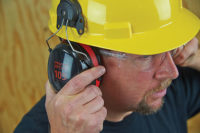
A new employee has a lot to learn. Your training efforts encompass everything from hazard communication (hazcom) to emergency action plans, fire safety, first aid, personal protective equipment, respiratory protection, air contaminants and flammable liquid handling.
What do all of these training topics have in common?
They all can be approached during your hazcom training program. It sounds like a daunting task, but a thorough training program on hazcom will naturally touch on these other concerns to give trainees the big picture of how to work safely.
Hazcom requirements
OSHA’s requirements start with information on OSHA’s hazcom standard, the written hazcom program and work operations where hazardous chemicals are present. Additional training is outlined at 29 CFR 1910.1200(h)(3). Among these training elements are:
- Methods and observations used to detect hazardous chemicals
- Health hazards
- Personal protective equipment (PPE)
- Physical hazards
- Emergency procedures
The safest way to determine the presence or release of hazardous chemicals is through the use of air monitoring equipment. On the job, employees may have to check on instruments connected to process equipment or participate in personal exposure monitoring programs. The equipment looks complicated to someone who has no previous experience with it.
Because employees might think that any reading on an air monitor indicates a hazardous exposure, this is a good time to introduce information on health hazards. Also emphasize that there are safe levels of exposure, and exposure limits are established for this purpose. Explain that odor is not a reliable indicator, so equipment is used to monitor contaminant levels.
Demonstrate how monitoring equipment is used. Provide the trainees with information on previous monitoring results, relate them to the exposures they can expect on the job and describe any signs or symptoms that could indicate overexposure while they work with chemicals. OSHA’s standard on air contaminants doesn’t have any employee training requirements, but you’ll probably want to refer to excerpts from its tables of exposure limits during hazcom training. Let the trainees practice finding information on exposure limits and health hazards on copies of material safety data sheets (MSDSs).
Hazcom and PPE
When trainees have a basic understanding of how exposure to a chemical can affect their health, they’ll want to know how they can protect themselves. This phase of hazcom training lends itself to an introduction to personal protective equipment.
You might want to revisit detailed PPE training another day, but let the trainees try on PPE during hazcom training. Having a chance to handle the gloves, eye and face protection, protective clothing and other equipment they’ll use on the job will make the trainees feel more confident about the protective measures you have in place to keep them safe.
Hazcom and respiratory protection
If employees will need to wear respirators, this is an excellent time to introduce your respiratory protection program. It isn’t the right time for a fit test, but at least show the trainees the respirator they’ll be using. Discuss the procedures for the medical evaluation and explain your organization’s requirements for clean-shaven employees if they wear respirators with tight-fitting facepieces.
Hazcom and physical hazards
Information on a chemical’s physical hazards is found on its MSDS. Most people have a good idea of what “flammable,” “combustible” and “explosive” mean, but they may not be too familiar with terms like “oxidizer” or “pyrophoric.” Focus the training only on the hazards the employees will encounter, but go beyond an explanation of the terms.
The information you provide will be tailored to your operations, but some suggestions include:
- Showing employees the safety precautions used in chemical storage areas;
- Demonstrating bonding and grounding techniques during flammable liquid transfer operations;
- Demonstrating how to move a compressed gas cylinder.
After you discuss the possibility of fires and explosions, trainees will want to know what they should do in an emergency situation. Show them how to activate alarms and demonstrate your evacuation procedures. Do you want workers to use portable fire extinguishers? Now’s the time to explain your policies.
All this talk about chemical hazards makes trainees worry about injuries, too. Start with a demonstration of how to use emergency eyewash and shower equipment. Explain how to report an injury and how employees get medical treatment.
Put it into practice
A good approach to hazcom training anticipates the trainees’ concerns and brings together practical information related to other OSHA requirements.
Workers should leave hazcom training with some familiarity of how they’ll incorporate all aspects of chemical safety on the job. The goal is to have workers understand the hazards and control measures so they’re comfortable working with chemicals while maintaining a healthy respect for their hazards.
SIDEBAR: Hybrid hazcom training Blend Web-based and live instruction
By ISAAC POWELLAs part of any organization’s management of hazardous materials, many employees must complete training programs that range from general awareness to more specific areas such as chemical spills or the management of hazardous waste. Hazard communication (hazcom) training is one of the most common types of training because it is required by OSHA for all employees who have the potential to be exposed to hazardous materials in the workplace.
Companies frequently make the mistake of offering limited or abbreviated HazCom training to new employees in the interest of saving time or minimizing costs. Yet lack of adequate training is one of the most common violations cited during routine inspections or resulting from accidents or injuries that occur in the workplace. Investing up front in the quality of your employee hazcom training program could prove to be a highly effective means of reducing your risk of non-compliance as well as costs associated with fines and workers’ compensation claims.
Types of training
Hazard communication training is typically conducted in one of four ways:
- Pre-packaged;
- Stand and deliver;
- Web-based;
- A hybrid approach, blending one or more of the other traditional training methods.
With interactive CD-ROMs and the Internet, many companies are now taking a self-paced, “e-learning” approach, which has the potential for great cost savings but can be handicapped by low employee motivation. A hybrid approach combines Web-based training and live training into a single training tool. This “blended learning” offers the effectiveness of an on-site instructor while providing the flexibility and cost savings provided by Web-based learning.
Hybrid hazcom training
Hazcom training is a good candidate for blended learning because the basic components of the training program can be delivered effectively through self-paced, Web-based training. These include understanding the hazcom standard, state-specific regulations and the employer’s written hazcom program. The instructor-led portion can then focus on relating these basic components to employees’ day-to-day job functions as well as motivating and cultivating employee enthusiasm for safety. Start moving toward a hybrid training program by taking several steps:
1) Increase the percentage of Web-based to instructor-led training sessions to 25 percent and 75 percent, respectively.
2) Move to a 50/50 split between the two methods as your employees gain confidence in using Web-based training.
3) Graduate to a 75 percent Web-based, 25 percent instructor-led balance (or a similar split that is suitable to your organization).
4) Focus on knowledge or information delivery through the Web and live interaction being delivered by a qualified instructor.
Isaac is Product Manager for 3E Company’s Technical Services. He can be reached by email at ipowell@3ecompany.com, or by phone at (760) 930-6638.




